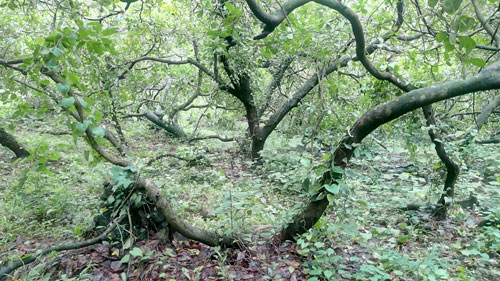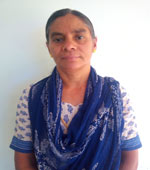Aniyamma Baby (55) is a progressive plantation farmer and homemaker. She has developed an innovative multiple-rooting system method for cashew nut propagation. This method aims to create multiple roots in a grownup cashew tree to improve unit area production, manage stem and root borers, extend plantation life, and restore productivity in the senile cashew gardens.
She observed that the old cashew plantations of poor farmers are always under constant threat of diseases, insect pests and uprooting of trees due to cyclones. Observing the rooting and development process of a new plant from the branch of the mother plant, she thought of developing new plants by giving weight to branches close to the ground and covering them with soil for rooting. She has been using this method in the old senile plantations for the last seven years.
Two approaches followed by her to initiate rooting in a grownup cashew tree are:
1. A sac filled with potting mixture (soil and cow dung) is tied on the lower branches of cashew growing parallel to the ground. After one year, rooting occurs at that point. These new roots are then guided through hollow areca nut stems filled with soil and cow dung to the ground. In little over a year, the roots shall develop and add to the root network of cashew. It will help as additional channels for nutrient and water uptake to the plant and will be helpful to improve the yield.
2. She heaps stones around the nodes of trees with low-lying branches and covers them with soil and cow dung. Rooting occurs at these points, and these branches grow as new trees while remaining part of the main tree. She has successfully initiated the rooting of branches lying in rocky areas.
The uniqueness of the method is that it is cost-effective technology to increase and restore the productivity of cashew crops in a short time. It is an eco-friendly method for in-situ plant multiplication and managing severe stem and root borer attacks. Being a climate-resilient (cyclone and storm) technology to protect old cashew plantations, it gives higher yield due to fast plant growth and more flowering/fruiting. It facilitates utilization of rocky areas for plant multiplication and sustainable use of cashew plantation areas.
The technology was validated by ICAR- Directorate of Cashew Research, Puttur and Kerala Agriculture University for its innovativeness. They opined that the technology is unique and can be helpful for the cashew farmers having old and senile cashew gardens to realize additional yield by improving nutrient and water uptake and by providing an additional sink for flower and fruit production. The technology also helps provide anchorage against wind damage/cyclonic storms and helps to extend the plantation life also without replanting.
Kerala Agriculture University scientists observed that this new technology offers hope and a new method to restore cashew productivity in senile plantations and could be a potential for farmers and eco-friendly technique to restore cashew trees from a severe attack of cashew stem and root borer, which is a debilitating pest in cashew.
The technology is recommended as a cost-effective, innovative method of managing cashew root development to increase production and provide eco-friendly management technique for crop loss due to pest attacks and giving extra anchorage to prevent damage from cyclonic storms in the coastal regions. To date, about 600 farmers from five districts of Kerala have been trained by Aniyamma in this technique.
Aniyamma Baby (55) is a progressive plantation farmer and homemaker. She has developed an innovative multiple-rooting system method for cashew nut propagation. This method aims to create multiple roots in a grownup cashew tree to improve unit area production, manage stem and root borers, extend plantation life, and restore productivity in the senile cashew gardens.








-2.jpg)
-1.jpg)
